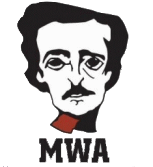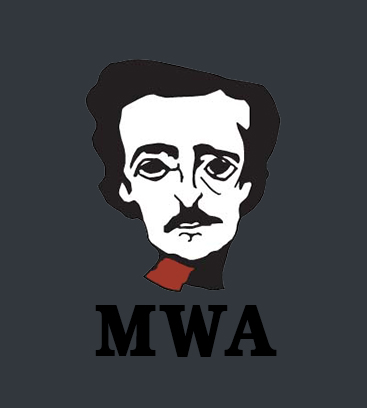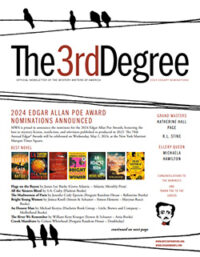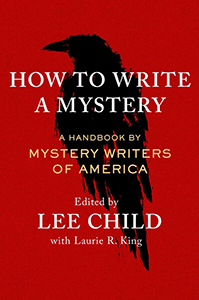Mystery Writers of America: A Historical Survey
MWA is Born
- Mystery Writers of America, Inc was established in 1945 by a dozen or so like-minded mystery writers for the purpose of promoting and protecting the interest and welfare of mystery writers and to increase the esteem and literary recognition given to the genre.
- The who’s who of 54 writers attending an early organizing meeting included: Howard Haycraft, Erle Stanley Gardener, Dorothy B. Hughes, Anthony Boucher, Rex Stout, Stuart Palmer, the Q. Patrick team, Fred Dannay and Manfred Lee (Ellery Queen), Helen Reilly, Octavus Roy Cohen, Leo Zagat. Roger Torrey, Kurt Steele, and the Lockridges.
- The writers decided that the slogan of the new organization should be “Crime Does Not Pay – Enough.”
- Clayton Rawson, who had proposed the catchy slogan, suggested that the organization newsletter be called The Third Degree (TTD). He became TTD’s first editor.
- Faced with the task of coming up with a mailing list of prospective members, MWA turned to Howard Haycraft’s landmark work, Murder for Pleasure.
Chapters Formed
- With the national headquarters established in New York City, MWA chapters were set up in Chicago and California.
- The New England Chapter was formed in 1971. Other regional chapters followed as interest in the organization grew.
- Over the years, eleven regional chapters were established: New York, SoCal, NoCal, Midwest, New England, Rocky Mountain, Southeast, Southwest, Northwest, Florida, and the most recently organized chapter, Mid-Atlantic.
Rental Libraries and Publishing Contracts
- One of the first issues taken up by MWA was rental library sales. As Lawrence Treat recalled, in this era before the mass production of paperback books, “a paperback involved a limited print run. . .and our main sales for our two-dollar books were to rental libraries.” Unfortunately, no matter how many times the book was rented out, the author only received royalties on the single copy sold to the library.
- At the second MWA meeting, the writers discussed getting “a fair share of the subsidiary rights.” As Lawrence Treat put it, “If we didn’t get rich, we at least expected to get justice.”
- This concern led the members to suggest that the price of a mystery paperback be raised by fifty cents (from $2.00 to $2.50) and the additional profit split between writer and publisher.
- MWA developed a model contract which one publisher, Ziff-Davis, signed.
The First MWA Anthology
- To bolster the organization’s treasury, MWA set up an anthology series. The first anthology, Murder Cavalcade, was published in 1946 by Duell, Sloan, and Pierce. The un-credited editor was Ken Crossen. Richard Lockridge wrote the foreword.
- Currently, MWA averages about one short-story anthology per year. These themed anthologies are edited by best-selling writers and provide a showcase for MWA members.
Eddie Lends His Name to MWA Award
- In the 1840s, Edgar Allan Poe wrote the three short stories featuring C. Auguste Dupin that established Poe as “The Father of the Detective Story.” In 1945, the coveted Edgar® Award was named in honor of Poe.
- Reminiscing about how the Edgar® Award came to be Dorothy B. Hughes recalled: “It was yet another step in dignifying the mystery writer, in enhancing his work, and let’s face crass materialism. . .anything that enhances the author and his work means more money in his pocket” (TTD, April 1974).
- To highlight the award, Clayton Rawson came up with another terrific idea – an annual banquet at which the Edgar® for the “Best First Novel” of the year would be given to the winner. At that first banquet (see below), Watchful at Night, by Julian Fast, received Best First Novel.
- In 1950, the Edgar® for the Best Play was awarded for the first time. A year later, in 1951, the Edgar® for the Best Short Story premiered.
- In 1952, recognizing an important new medium, the first Edgar® for Best Television Episode was awarded. In 1960, the last Edgar® for the Best Radio Drama was awarded.
- In 1953, after much debate about whether it was appropriate or even possible to choose one book each year to give such a distinction, a “Best Novel” category was added. Charlotte Jay won the first Edgar® in this category with Beat Not the Bones.
- 1953 was also the year when the Raven was awarded for the first time.
- In 1954, MWA created the Grand Master award.
- Although the awards criteria have remained sensitive to changing conditions and needs, the awards were described in general terms by Hilary Waugh in the January 1963 TTD.
And the Winner Is. . .the Edgar® Awards Dinner
- In 1946, the first Edgar® Awards Dinners was held. In addition to the award for Best First Novel, awards were given for Best Motion Picture, Best Radio Drama, and Outstanding Mystery Criticism.
- Since its inception, the Edgar® Awards Dinner has taken place in various locales in New York City. From the Henry Hudson Hotel, the festivities moved to the Astor, then the Biltmore, had a brief stay at the Stork Club, and then Toots Shor’s Restaurant. Now held at the Grand Hyatt Hotel, the Edgar® Awards Dinner remains the occasion when mystery writers can “dress to kill.”
- In the first year, Edgar® winners received a special leather-bound edition of Poe made for the occasion by Viking Press. In the second year, the award was a special Limited Edition of 12 copies of Howard Haycraft’s Art of the Mystery Story. The small ceramic statuettes of Poe, designed by Peter Williams, appeared in the third year.
- Of the awards MWA bestows at the Edgar® Awards Dinner, none is more prestigious and coveted than the Grand Master. This award was established in 1954 to recognize not only important contributions to the mystery over time, but a significant output of consistently high quality as well. The first recipient was Dame Agatha Christie.
- Each year, the speech delivered by the recipient of the Grand Master award is a highlight of the Edgars® Awards Dinner.
Not Just the Usual Suspects
- The mystery genre has attracted a diverse cross-section of writers and readers. For example, among those honored with Edgar®, special Edgar®, Raven, and Ellery Queen awards are: Franklin Delano Roosevelt who received a posthumous Raven in 1959; Gore Vidal who won a 1955 for “Smoke,” in the category of Best Television Episode; the Royal Shakespeare Company, which received the 1979 Raven for the revival of the play Sherlock Holmes; and in 1993, President Bill Clinton, another First Reader, received a Raven.
MWA Goes to College
- In 1979, the first MWA/John Jay College of Criminal Justice Symposium was presented.
- The symposium was the idea of Flora Rheta Schreiber, the author of Sybil, who was a faculty member and the Director of Public Relations at John Jay.
- The symposium is still held each year during Edgars® week and continues to offer attendees star-studded panels of authors and other experts who discuss the craft of writing and the latest technologies and trends in crime solving.
Preserving History
- MWA has served as historian for the American mystery, procuring and storing in its library the important documents and markers of the passing years and the changes within the profession.
- Among the treasures in the MWA archives is a taped interview of James M. Cain, the 1970 Grand Master, by MWA members Hillary Waugh, Stanley Ellin, and Chris Steinbrunner.
- By 1968, the MWA library was reputed to be one of the most extensive collections of mystery fiction and the repository of much reference information useful to mystery writers. Editors and movie people looking for backlist books for reprint or film sales often used the MWA library.
- Today, the bulk of this collection, as well as MWA office files and archives from its first forty years, are housed at the Lilly Library at Indiana University in Bloomington, IN
- The MWA headquarters library still contains hundreds of novels and reference books, and is used extensively by its members, editors, publishers, and the film industry.
- The reference section of the MWA library was formally established in 1968 as the “Anthony Boucher Memorial Reference Library” in memory of Tony Boucher’s distinguished work as editor, critic, author, longtime member and co-founder of MWA.
Creating the Writers of Tomorrow
- In 1998, MWA established Kids Love a Mystery, a youth literacy program that encourages children and teens to read mysteries.
- Now called MWA: Reads the program joins with students, parents, teachers, and librarians to sponsor The Joan Lowery Nixon Award mystery writing contest, now in its third year.
Last updated February 21, 2008. MWA offers special thanks to Barry and Angela Zeman who in 2000 prepared the document from which most of these highlights were gleamed. Their more detailed and fascinating account of the organization’s history is available in the MWA archives.



